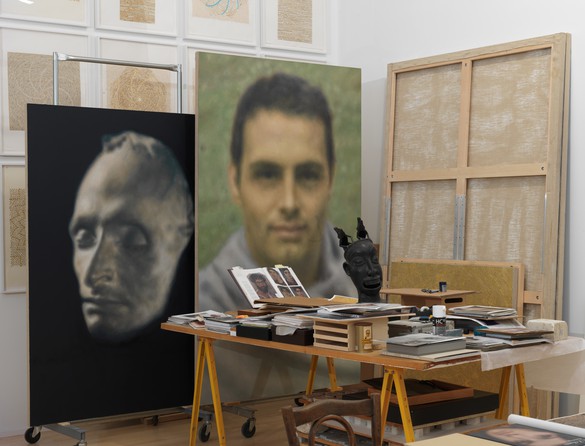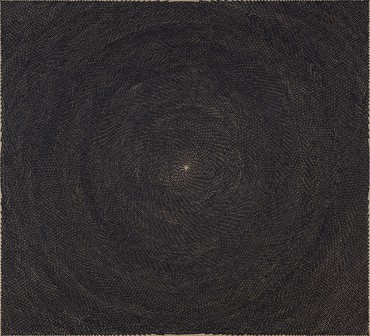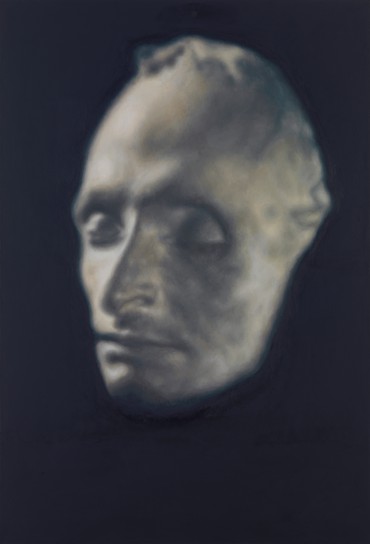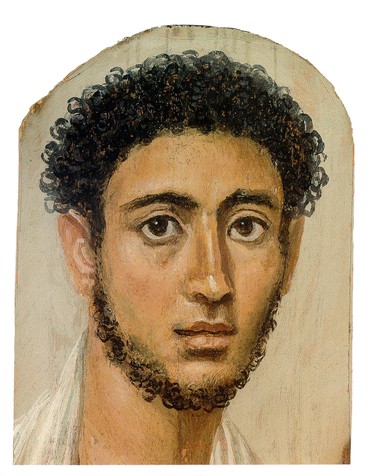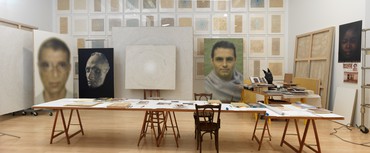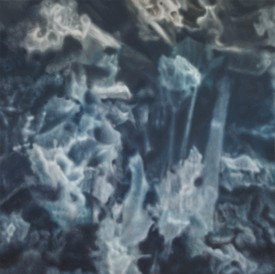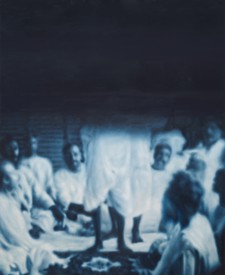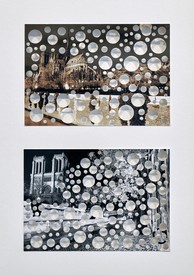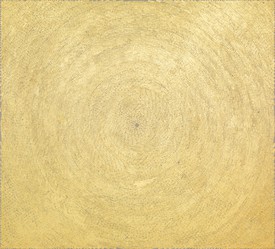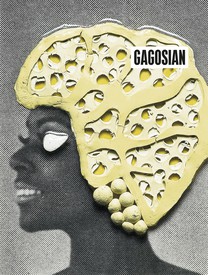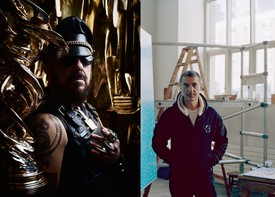
Angela Brown is a writer and editor from Yonkers, New York. She is currently a PhD student in modern art history at Princeton University.
“Nature is an infinite sphere whose centre is everywhere and circumference nowhere.”
Blaise Pascal
In Y.Z. Kami’s Dome paintings, multitudes of rhythmic marks aggregate in concentric circles. The patterned dabs of paint expand from, or collapse into, blurred centers: a series of voids and apertures that recall architectural domes. Standing before one of these works, the circles seem to pulse in time, dilating, like eyes adjusting to the light.
In many portraits, whether painted or photographed, a tiny eclipse can be found in each of the sitter’s eyes: two circles of light orbiting two dark and impenetrable voids, pulling the viewer in. In Kami’s portraits, however, the sitter’s face floats behind a matte haze, hovering between distance and proximity. Instead of focal points, Kami offers an experiential blur. Like the celestial evocations of the architectural dome, these are portraits of the ineffable: physical representations of the unknown and the unseen.
Geometry of Light, Kami’s exhibition at Gagosian Paris, includes new and recent Dome paintings, as well as three new portraits: of the artist himself; of his partner Daniele; and of the death mask of Blaise Pascal, the seventeenth-century French mathematician, writer, and Christian theologian. Kami sees the exhibition as an homage to Pascal, mapping the deep-seated parallels between geometric and spiritual representations of infinity. In addition to the more explicit geometries of the Domes and the religious allusion of the painting Daya’s Hands II (2015–16), showing two hands with palms pressed together in prayer, the exhibition also contains many subtle dramaturgical choices that speak to the overlap between shape and spirit. The portraits’ gazes and the Domes’ centers create invisible triangulations through the space, enclosing the viewer in a geometric matrix of intersecting lines of sight.
Pascal is a major figure in the history of science, mathematics, and philosophy. His inventions include early prototypes of the mechanical calculator, the hydraulic press, and the syringe, and his mathematical findings continue to be used today: from Pascal’s triangle, which diagrams binomial expansions and other arithmetical patterns, to various theorems on probability, truth, and definition. In the late 1650s, Pascal wrote De l'Esprit géométrique (On the geometrical spirit), in which he argued that it was impossible to completely prove a mathematical solution, since all proof would need to be supported by already established truths. Therefore, no “first principles” or primary truths can exist, as all numbers and formulae are human inventions, symbolic markers used as stand-ins for such intangible notions as infinity, time, and—as Kami emphasizes—light. This conclusion, in Pascal’s view, only strengthened what he saw as the “perfection” of geometry. He writes:
None of these truths can be demonstrated, and yet they are the foundations and the principles of geometry. But since the cause that makes them incapable of demonstration is not their obscurity but on the contrary their extreme evidence, this lack of proof is not a defect but rather a perfection.1
In other words, geometry is able to provide clear and detailed evidence based on a set of givens, but those givens—despite being the simplest elements of the formula—can never themselves be proven. The discipline of geometry, then, can be compared to a dome in a church, mosque or temple: in place of what cannot be perceived (the heavens), it sets up complex relationships between what can be perceived (humans, architecture, and the sky).
Kami began to depict architectural domes in the mid-1990s with a series of black and white photographs of large domes in sacred spaces, with rectangular bricks laid in repetitive, hypnotic patterns. Eventually, he merged this meditative visual effect with his interest in text, creating the Endless Prayers works, in which fragments of printed text—from the songs and poems of Rumi to the psalms of David—are arranged in mandala-like formations. The subject of much of these texts is an appeal to a higher power, or deference to the inexplicable forces of life and nature. Reading them, especially in Kami’s kaleidoscopic compositions, induces a state of introspection. As one concentrates on the text and patterns, a sort of tabula rasa opens up in the mind, like lullabies for thought. Similarly, the Dome paintings—which in Geometry of Light are white, black, or gold—allow for the gaze to be turned inward. Rather than staring up towards a real dome’s oculus, the viewer approaches these abstract vortexes at eye level. The brick-like marks in the white Domes go from being specific in the outermost circles—where they are evenly separated and countable—to general, fading into a field of luminous white at the center of the canvas. As Pascal observed when considering the origins of geometric proofs, it is the center, the limits, and the origin that are the most difficult to define. The Domes are thus slices of proof somewhere on the way between the infinitely large and the infinitely small.
Portraits, too, are slices of proof: frozen moments of a person’s life somewhere on the way between birth and death. Though in recent history portraits are made for the sake of commemoration and posterity, this was not always the case. During the first to third centuries in Egypt, Fayum portrait painters played a different role. They depicted each sitter, eyes wide open, usually at the prime of their life. The completed portraits, often in tempera paint and encaustic on wood, were meant to be attached to the person’s mummy when he or she died. Made to disappear along with their subjects, they, too, entered the necropolis.
Compared to the mirroring sensation produced by the eyes in famous portraits like Vermeer’s The Girl with the Pearl Earring (1665), the eyes in the Fayum portraits somehow produce the opposite feeling. John Berger, in discussing these paintings, emphasizes that the idea of an artist’s ego or unique style had not yet taken hold. Rather than attesting to the painter’s skill or becoming historical documents, the Fayum portraits served a practical purpose in the journey to the afterlife. They were not meant to outlive their subjects. In Berger’s words:
The Fayum painter was summoned not to make a portrait, as we have now come to understand the term, but to register his client, a man or a woman, looking at him. It was the painter rather than the ‘model’ who submitted to being looked at.2
Kami’s portraits take this role reversal a step further. Out of focus, they occasionally look out at the viewer, but the viewer cannot see them clearly. Each face seems to retreat as the viewer approaches, equally intimate and inaccessible. The portrait of Daniele, for example, looks across the gallery at Daya’s Hands II. With a blue-gray scarf draped around his shoulders, he smiles slightly, yet his countenance maintains a level of mystery. It is on the verge of dissolution, like the green field atomizing behind him. Kami’s self-portrait is even more blurred, implying that the most difficult person to truly see is oneself.
On a January afternoon in his studio, thinking about what it means to paint such familiar faces, Kami explained, “When I know a person very well, I want [the portrait] to look very much like the experience I have of that face, which is a constant experience. This is more of a challenge with a face that I know well than with someone who is more of a stranger.” Here, as with the Domes, Kami’s work echoes Pascal’s theories—with a portrait, even as you know more and more about a person, there is a central core that cannot be represented, or even accessed. This unrepresentable center is the lived experience of the face-to-face encounter. When we see a face, we construct ourselves in relation to it, forming a complex set of relative qualities, memories, and emotions. But, no matter how much we experience the face, no matter how many mornings we find our own face in the mirror, there is always something that cannot be understood. The eyes hide even more than they reveal.
Kami’s portraits capture this paradox. They abandon the comforts and conventions of clarity in favor of the affective tremor of the unknown. In Masque mortuaire de Pascal (Pascal’s death masque), 2017, Pascal’s eyes remain closed, frozen in eternal contemplation. The white plaster mask emerges from a dark void, its heavy eyelids forming domes of their own. The mathematician-theologian, in death, comes to embody his theories—evoking infinity through the finite.
In Geometry of Light, Kami taps into a logic that sits between the vanishing point and the void, exploring the gap between clarity and obscurity. The viewer, eyes wide before a Dome painting, feels he or she is at the center of the universe, only to turn around and see another face, peering into the same vanishing point, or another vanishing point at the other side of the room. Who is looking at whom? Rather than emplace the viewer in a specific place and time, the blurred eyes, golden domes, white voids, and pinhole-like center of Black Dome (2017) all contradict each other. They are permutations of infinity, causing the viewer to question where he or she is in relation to what is represented. And as the eyes struggle to focus, it is as if the viewer, too, is moving farther and farther away, standing behind each vanishing point and watching as the rays of light converge.
1Blaise Pascal, as cited in Barry Stocker, “Pascal and Derrida: Geometry, Origin and Discourse,” Symposium IV, 1 (2000), 124.
2John Berger, “The Fayum Portrait Painters (1st-3rd century),” in Portraits (Verso, 2016).
Artwork © Y.Z. Kami. Photos by Rob McKeever
